Beechcraft Model 18
| Model 18 | |
|---|---|

| |
| Instructor and pilot in an AT-7 doing navigation training at Kelly Field, TX. | |
| Role | Trainer and utility aircraft |
| National origin | United States |
| Manufacturer | Beech Aircraft Corporation |
| First flight | January 15, 1937 |
| Introduction | 1937 |
| Primary users | United States Army Air Forces United States Navy Royal Air Force Royal Canadian Air Force |
| Produced | 1937–1970 |
| Number built | 9,000+ |
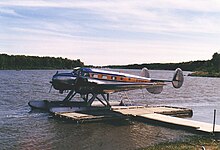
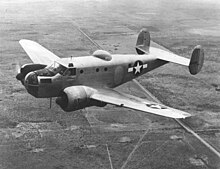

The Beechcraft Model 18, or "Twin Beech", as it is better known, is a six- to 11-seat,[1] twin-engined, low-wing, tailwheel aircraft manufactured by the Beech Aircraft Corporation of Wichita, Kansas. This model saw military service during and after World War II in a number of versions, including the United States Army Air Forces (USAAF) C-45 Expeditor, AT-7 Navigator, AT-11 Kansan; and for the United States Navy (USN), UC-45J Navigator and the SNB-1 Kansan.
In addition to carrying passengers the aircraft's uses have included aerial spraying, sterile insect release, fish seeding, dry ice cloud seeding, aerial firefighting, air mail delivery, ambulance service, numerous movie productions, skydiving, freight, weapon- and drug-smuggling, engine testbed, skywriting, and banner towing. Many are now privately owned.
Design and development
By the late 1930s, Beechcraft management speculated that a demand would exist for a new design dubbed the Model 18, which would have a military application, and increased the main production facilities. The design was mainly conventional for the time, including twin radial engines, all-metal semimonocoque construction with fabric-covered control surfaces and tailwheel undercarriage. Less conventional was the twin-tailfin configuration. The Model 18 can be mistaken for the larger Lockheed Electra series of airliners which closely resemble it. Early production aircraft were powered either by two 330-hp (250-kW) Jacobs L-6s or 350-hp (260-kW) Wright R-760Es. The 450-hp (336-kW) Pratt & Whitney R-985 became the definitive engine from the prewar C18S onwards. The Beech 18 prototype first flew on 15 January 1937.
Prior to the Pearl Harbor attack, the Beech 18 was outsold by the Lockheed 12 by two-to-one. However, war priorities forced Lockheed to concentrate on its heavier aircraft, and Beechcraft received a major boost through wartime contracts.[citation needed]
The aircraft has used a variety of engines and has had a number of airframe modifications to increase gross weight and speed. At least one aircraft was modified to a 600-hp (447-kW) Pratt & Whitney R-1340 powerplant configuration. With the added weight of about 200 lb (91 kg) per engine, the concept of a Model 18 fitted with R-1340 engines was deemed unsatisfactory due to the weakest structural area of the aircraft being the engine mounts. Nearly every airframe component has been modified.
In 1955, deliveries of the Model E18S commenced; the E18S featured a fuselage that was extended 6 in (150 mm) higher for more headroom in the passenger cabin. All later Beech 18s (sometimes called Super 18s) featured this taller fuselage, and some earlier models (including one AT-11) have been modified to this larger fuselage. The Model H18, introduced in 1963, featured optional tricycle undercarriage. Unusually, the undercarriage was developed for earlier-model aircraft under an STC by Volpar, and installed in H18s at the factory during manufacture. A total of 109 H18s were built with tricycle undercarriage, and another 240 earlier-model aircraft were modified with this.[2][3]
Construction of the Beechcraft Model 18 ended in 1970 with a final Model H18 going to Japan Airlines. Beechcraft set a record that still stands today for the longest continuous production of a piston-engine aircraft.[citation needed] Through the years, 32 variations of the basic design had flown, over 200 improvement modification kits were developed, and almost 8,000 aircraft were built. In one case, the aircraft was modified to a triple tail, trigear, humpbacked configuration and appeared similar to a miniature Lockheed Constellation. Another distinctive conversion was carried out by PacAero as the Tradewind. This featured a lengthened nose to accommodate the tricycle nosewheel, and the Model 18's twin tailfins were replaced by a single fin.[4]
Operational history
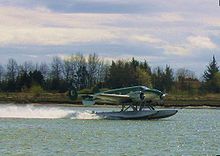
Production got an early boost when Nationalist China paid the company US$750,000 for six M18R light bombers,[5] but by the time of the U.S. entry into World War II, only 39 Model 18s had been sold, of which 29 were for civilian customers.[2][6] Work began in earnest on a variant specifically for training military pilots, bombardiers, and navigators. The effort resulted in the Army AT-7 and Navy SNB. Further development led to the AT-11 and SNB-2 navigation trainers and the C-45 military transport. The United States Air Force Strategic Air Command had Beechcraft Model 18 (AT-11 Kansans, C-45 Expeditors, F-2 Expeditors (the "F" standing for "Fotorecon"), and UC-45 Expeditors) from 1946 until 1951. From 1951 to 1955, the USAF had many of its aircraft remanufactured with new fuselages, wing center sections, and undercarriages to take advantage of the improvements to the civil models since the end of World War II. Eventually, 900 aircraft were remanufactured to be similar to the then-current Model D18S and given new designations, constructor's numbers and Air Force serial numbers.[7] The USN had many of its surviving aircraft remanufactured, as well, these being redesignated as SNB-5s and SNB-5Ps.[citation needed] The C-45 flew in U.S. Air Force service until 1963, the USN retired its last SNB in 1972, while the U.S. Army flew its C-45s through 1976. In later years, the military called these aircraft "bug smashers" in reference to their extensive use supplying mandatory flight hours for desk-bound aviators in the Pentagon.[8]
Among the most notable cooling air and exhaust modifications were those engineered by Benjamin Israel while employed by Conrad Conversions. His modifications were based largely on creating a more efficient use of cooling air to reduce drag, a major detriment to cruise performance. Cruise performance was improved 10% or more at the same power settings as before the modifications. These modifications were largely copied on the factory-produced G and H models. Beech 18s were used extensively by Air America during the Vietnam War; initially more-or-less standard ex-military C-45 examples were used, but then the airline had 12 aircraft modified by Conrad Conversions in 1963 and 1964 to increase performance and load-carrying capacity. The modified aircraft were known as Conrad Ten-Twos, as the maximum takeoff weight (MTOW) was increased to 10,200 lb (4,600 kg).[9][10] The increase was achieved by several airframe modifications, including increased horizontal stabilizer angle-of-incidence, redesigned undercarriage doors, and aerodynamically improved wingtips. Air America then had Volpar convert 14 aircraft to turboprop power, fitted with Garrett AiResearch TPE-331 engines; modified aircraft were called Volpar Turbo Beeches, and also had a further increase in MTOW to 10,286 lb (4,666 kg).[9]

A factory option at one point was the addition of JATO bottles on each engine nacelle which added the equivalent of 200 hp (150 kW) per engine for about 12 seconds. The most successful powerplant upgrade was that of the Pratt & Whitney Canada PT6 turbine engine and Hartzell propeller. This conversion was carried out by Hamilton Aircraft in the 1960s and 70s as the Hamilton Westwind, successfully extending the commercial life of the aging aircraft. The Westwind II added a fuselage stretch to provide seating for 17 passengers, the Westwind III seated eight and used the remainder of the extra room for cargo, and the Westwind IV added an extra stretch and a large cargo door.
Spar problems
The wing spar of the Model 18 was fabricated by welding an assembly of tubular steel. The configuration of the tubes in combination with drilled holes from aftermarket STC modifications on some of these aircraft have allowed the spar to become susceptible to corrosion and cracking while in service.[11] This prompted the FAA to issue an Airworthiness Directive in 1975, mandating the fitting of a spar strap to some Model 18s. This led, in turn, to the retirement of a large number of STC-modified Model 18s when owners determined the aircraft were worth less than the cost of the modifications. The corrosion on unmodified spars was not a problem, and occurred due to the additional exposed surface area created through the STC hole-drilling process. Further requirements have been mandated by the FAA and other national airworthiness authorities, including regular removal of the spar strap to allow the strap to be checked for cracks and corrosion and the spar to be X-rayed. In Australia, the airworthiness authority has placed a life limit on the airframe, beyond which aircraft are not allowed to fly.[12][13][14]
Variants
Manufacturer models
Unless otherwise noted, the engines fitted are Pratt & Whitney R-985 radials.
- Model 18A
- First production model with seating for two pilots and seven or eight passengers, fitted with Wright R-760E-2 engines of 350 horsepower (260 kW), MTOW: 6,700 lb (3,000 kg)[15][16]
- Model S18A
- Version of Model 18A capable of being fitted with skis or Edo 55-7170 floats; MTOW: 7,200 lb (3,300 kg)[16]
- Model 18B
- Improved model with increased range and useful load, fitted with 285 hp (213 kW) Jacobs L-5 engines[15][17][18]
- Model S18B
- Version of Model 18B capable of being fitted with skis or floats.
- Model 18D
- Variant with seating for two pilots and nine passengers, fitted with Jacobs L-6 engines of 330 horsepower (250 kW), MTOW: 7,200 lb (3,300 kg).[19]
- Model S18D
- Version of Model 18D capable of being fitted with skis or Edo 55-7170 floats, MTOW: 7,170 lb (3,250 kg)[6][19]
- Model A18D
- Variant of 18D with MTOW increased by 300 lb (140 kg) to 7,500 lb (3,400 kg), fitted with Pratt and Whitney R-985 engines with 450 hp each[19]
- Model SA18D
- Seaplane version of Model A18D, but same MTOW as S18D, fitted with Edo 55-7170 floats[19]
- Model A18A
- Version fitted with Pratt and Whitney R-985 engines of 450 horsepower (340 kW), MTOW: 7,500 lb (3,400 kg)[19]
- Model SA18A
- Seaplane version of Model A18A, fitted with Edo 55-7170 floats, MTOW: 7,170 lb (3,250 kg)[19]
- Model 18R
- Model with Pratt and Whitney R-985-A1 engines with dual-stage blower for increased power at higher operating altitudes, 450 horsepower (340 kW), seven built, one to Sweden as an air ambulance, six to Nationalist China as M18R light bombers[5][15]
- Model 18S
- Nine-passenger pre-World War II civil variant, served as basis for USAAF C-45C[1]
- Model B18S
- Nine-passenger pre-World War II civil variant, served as basis for USAAF F-2[1]
- Model C18S
- Variant of B18S with seating for eight passengers, and equipment and minor structural changes[20]
- Model D18S
- First post-World War II variant introduced in 1945, with seating for eight passengers and MTOW of 8,750 lb (3,970 kg), 1,035 built[21][22]
Two hundred and eighty 280 D Models were made for the Royal Canadian Air Force (RCAF) and given the service name 'Expeditor', and they were delivered between 1951 and 1952. (Their serial numbers ranged from CA-1 to CA-280.)[23] Seating for RCAF was for five passengers, or two RCAF Navigator students and one RCAF navigator instructor.[24] MTOW for RCAF was 9300 lbs.[25]
- 3N: Fitted as a navigation trainer with astrodome and two trainee stations in the cabin; 88 built[26]
- 3NM: Fitted primarily as a navigational trainer, and is fitted with floor lugs to accept transport seats on removal of navigation equipment; 59 built[27]
- 3NMT: Basically a 3NM, converted to a transport aircraft; 67 built[28]
- 3NMT(Special): Fitted as a navigation trainer personnel transport. First navigation training position retained, slightly modified ie: removal of air position indicator and replaced with radio compass and indicator from removed second navigation position; in addition, three reclining-type chairs fitted; 19 built[29]
- 3TM: Normally fitted with transport type seats, but has the necessary wiring, plumbing, and fittings for conversion to a navigation trainer, including provisions for fitting an astrodome; 44 built[26]
- 3TM(Special): Specifically modified RCAF Expeditor under Project WPB6, and refers specifically to overseas Expeditors; three built[30]
- Model D18C
- Variant with Continental R9-A engines of 525 horsepower (391 kW) and MTOW of 9,000 lb (4,100 kg), introduced in 1947, 31 built.[21][31]
- Model E18S
- Variant with redesigned wing and MTOW of 9,300 lb (4,200 kg); 403 built[21]
- Model E18S-9700
- Variant of E18S with MTOW of 9,700 lb (4,400 kg); 57 built[21]
- Model G18S

- Model H18
- Last production version, fitted with optional tricycle undercarriage developed by Volpar and MTOW of 9,900 lb (4,500 kg); 149 built, of which 109 were manufactured with tricycle undercarriage[2][21][22]
Military versions
- RC-45A
- Redesignation of all surviving F-2, F-2A, and F-2B aircraft by the USAF in 1948
- C-45B
- Based on C18S, but with modified internal layout; 223 ordered, redesignated UC-45B in 1943[20][33]
- Expeditor I: Some C-45Bs were supplied to the RAF under Lend-Lease.
- C-45C
- Two Model 18S aircraft impressed into the USAAF, redesignated UC-45C in January 1943[1][15][34]
- C-45D
- Designation given to two AT-7 aircraft converted as passenger transports during manufacture, redesignated UC-45D in January 1943[34][35]
- C-45E
- Designation given to two AT-7 and four AT-7B aircraft converted as passenger transports during manufacture, redesignated UC-45E in January 1943[34][35]
- C-45F
- Standardized seven-seat version based on C18S, with longer nose than preceding models;[20] 1,137 ordered, redesignated UC-45F[33]
- Expeditor II: C-45Fs supplied to the RAF and Royal Navy under Lend-Lease
- Expeditor III: C-45Fs supplied to the RCAF under Lend-Lease
- C-45G
- AT-7s and AT-11s remanufactured in early 1950s for the USAF to similar standard as civil D18S with autopilot and R-985-AN-3 engines; 372 aircraft rebuilt[7][36]
- TC-45G
- Multiengine crew trainer variant of C-45G; AT-7s and AT-11s remanufactured in early 1950s for the USAF to similar standard as civil D18S, 96 aircraft rebuilt[7][36]

- C-45H
- AT-7s and AT-11s remanufactured in early 1950s for the USAF to similar standard as civil D18S, with no autopilot and R-985-AN-14B engines; 432 aircraft rebuilt[7][37]
- TC-45H [21]
- RC-45J [21]
- In 1962, all surviving U.S. Navy SNB-5Ps were redesignated RC-45J.
- TC-45J [21]
- In 1962 all surviving U.S. Navy SNB-5s were redesignated TC-45J.
- UC-45J [21]
- AT-7 Navigator
- Navigation trainer based on C18S,[20] with an astrodome and positions for three students, powered by 450-hp Pratt & Whitney R-985-25 engines; 577 built[32][33]
- AT-7A
- Floatplane version of AT-7; six built[32]
- AT-7B
- Winterised AT-7; nine built[32]
- AT-11 Kansan
- Bombing and gunnery trainer for USAAF derived from AT-7, fuselage had small, circular cabin windows, bombardier position in nose, and bomb bay; gunnery trainers were also fitted with two or three .30-caliber machine guns, early models (the first 150 built) had a single .30-cal AN-M2 in a Beechcraft-manufactured top turret, later models used a Crocker Wheeler twin .30-cal top turret, a bottom tunnel gun was used for tail gunner training, 1,582 built for USAAF orders, with 24 ordered by Netherlands repossessed by USAAF and used by the Royal Netherlands Military Flying School at Jackson, Mississippi.[38][39]
- AT-11A
- Conversion of AT-11 as navigation trainer; 36 converted[39]
- CQ-3
- Conversion of UC-45F, modified to act as drone control aircraft, redesignated as DC-45F in June 1948[citation needed]
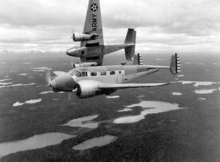
- F-2
- Photo-reconnaissance version based on B18[1]
- F-2A
- Improved version
- F-2B
- JRB-1
- Photographic aircraft for the U.S. Navy, based on the C18S,[20] fitted with fairing over cockpit for improved visibility, 11 built[40]
- JRB-3
- Photographic version, similar to C-45B; 23 built[40]
- JRB-4
- Utility transport version, equivalent to UC-45F'; 328 built.[40]
- JRB-6 [21]

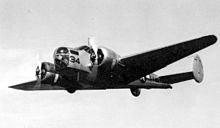
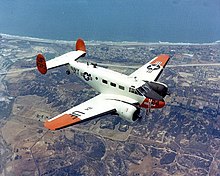
- SNB-2
- Navigation trainer for the U.S. Navy,[41] similar to AT-7, 299 built
- SNB-2C
- Variant for the U.S. Navy, similar to AT-7C[41]
- SNB-2H
- Ambulance conversion for the U.S. Navy[41]
- SNB-2P
- Photo-reconnaissance trainer for the U.S. Navy[41]
- SNB-3
- Variant for the U.S. Navy, similar to AT-7C
- SNB-3Q
- Electronic counter-measures trainer for the U.S. Navy
- SNB-5 [21]
- SNB-2s and SNB-2Cs were remanufactured, and designated SNB-5 by the U.S. Navy.
- SNB-5P [21]
- Photo-reconnaissance trainer for the U.S. Navy
Conversions
- PAC Super 18S Tradewind
- Custom conversion of Beech D-18S/C-45 to five- to 11-seat executive transport by Pacific Airmotive
- Hamilton HA-1
- conversion of a TC-45J aircraft
- Hamilton Little Liner
- Modification of D18S with aerodynamic improvements and new, retractable tailwheel, capable of carrying 11 seats[43]
- Hamilton Westwind
- Turboprop conversions with various engines
- Hamilton Westwind II STD
- two 840-hp PT6As
- Hamilton Westwind III
- two 579-hp PT6A-20s or 630-hp PT6A-27s or 630-hp Lycoming LTS101s.
- Hamilton Westwind IV
- two 570-hp Lycoming LTP101s or 680-hp PT6A-28s or 750-hp PT6A-34s or 1020-hp PT6A-45s
- Volpar (Beechcraft) Model 18
- Conversion of Model 18 with nosewheel undercarriage[44][45]
- Volpar (Beechcraft) Super 18
- Volpar (Beechcraft) Turbo 18
- Beech Model 18s fitted with the Volpar MkIV tricycle undercarriage and powered by two 705-hp Garrett TPE331-1-101B turboprop engines, flat-rated to 605 hp (451 kW), driving Hartzell HC-B3TN-5 three-bladed, reversible-pitch, constant-speed feathering propellers[45]
- Volpar (Beechcraft) Super Turbo 18
- 2x 705 hp (526 kW) Garrett TPE331
- Volpar (Beechcraft) C-45G
- C-45G aircraft modified with tricycle undercarriage
- Volpar (Beechcraft) Turboliner
- 15-passenger version of the Turbo 18 with extended fuselage, powered by 2 705-hp Garrett TPE331-1-101Bs[45]
- Volpar (Beechcraft) Turboliner II
- Turboliners modified to meet SFAR 23[45]
Operators
Civil
As of 2012[update], the Beechcraft Model 18 remains popular with air charter companies and small feeder airlines worldwide.
Military





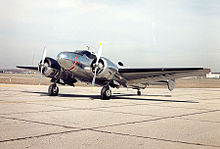
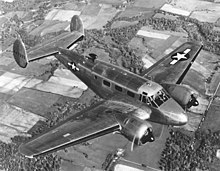
 Argentina
Argentina
 Bolivia
Bolivia
 Brazil
Brazil
- Royal Canadian Air Force 394 examples from 1941–1972[46]
- Royal Canadian Navy 10 examples from 1952–1960[47]
 Chile
Chile
 China/
China/ Taiwan
Taiwan Colombia
Colombia
 Costa Rica
Costa Rica Côte d'Ivoire
Côte d'Ivoire Dominican Republic
Dominican Republic Ecuador
Ecuador El Salvador
El Salvador France
France
 Guatemala
Guatemala
 Honduras
Honduras
 Indonesia
Indonesia
 Iran
Iran Italy
Italy Japan
Japan
 Mexico
Mexico
 Netherlands
Netherlands
 Nicaragua
Nicaragua
 Niger
Niger
 Nigeria
Nigeria Paraguay
Paraguay
 Peru
Peru
 Philippines
Philippines
 Portugal
Portugal
 Somalia
Somalia South Africa
South Africa
 Spain
Spain Sri Lanka
Sri Lanka
 Sweden
Sweden
 Switzerland
Switzerland
 Thailand
Thailand
 Tonga
Tonga
 Turkey
Turkey United Kingdom
United Kingdom
 United States
United States
 Uruguay
Uruguay Venezuela
Venezuela Zaire
Zaire
Aircraft on display
Notable appearances in media
Specifications (UC-45 Expeditor)

Data from Jane's Fighting Aircraft of World War II[82]
General characteristics
- Crew: 2 pilots
- Capacity: 6 passengers
Performance
See also
Aircraft of comparable role, configuration, and era
- Airspeed Oxford
- Avro Anson
- Barkley-Grow T8P-1
- Cessna AT-17 Bobcat
- De Havilland Dove
- Evangel 4500
- Fairchild AT-21 Gunner
- Lockheed Model 10 Electra
- Lockheed Model 12 Electra Junior
- Siebel Si 204
Related lists
References
Notes
- ^ a b c d e "Beech B18 Series Type Certificate." Federal Aviation Administration. Retrieved 8 August 2008.
- ^ a b c Beechcraft Heritage Museum Model 18 Specifications page.. Retrieved 24 August 2008.
- ^ Young, Shad. "The Beechcraft Model 18 & Volpar Tri-Gear – A Brief History". ascendant-online.net. Retrieved 8 August 2008.
- ^ "Expeditor." Canadian Museum of Flight. Retrieved 13 August 2012.
- ^ a b "Beechcraft page." Aerofiles. Retrieved 12 August 2008.
- ^ a b "S18D." Beechcraft Heritage Museum. Retrieved 12 August 2008.
- ^ a b c d Beechcraft Heritage Museum C-45H page.. Retrieved 24 August 2008.
- ^ O'Rourke, G.G, CAPT USN. "Of Hosenoses, Stoofs, and Lefthanded Spads." United States Naval Institute Proceedings, July 1968.
- ^ a b "Air America: Beech/Volpar Turbo Beech 18". University of Texas at Dallas, 2006. Retrieved 12 August 2008.
- ^ Deakin, John. "Pelican's Perch #75:Those Dreadful POHs (Part 1)". AVweb, 9 November 2003. Retrieved 12 August 2008.
- ^ Ramey, Taigh. "Spar concerns" (twinbeech.com)
- ^ Ramey, Taigh. "Things to Consider when Buying a Twin Beech Project". Vintage Aircraft, (twinbeech.com) Stockton, California. Retrieved 24 August 2008.
- ^ FAA Airworthiness Directive No. AD 75-27-09.. Retrieved 24 August 2008
- ^ "CASA Airworthiness Directive No. AD/BEECH 18/17." CASA. Retrieved 24 August 2008.
- ^ a b c d "USA Warplanes C-45 page." uswarplanes.net. Retrieved 24 August 2008.
- ^ a b "Beech 18A Series Type Certificate." Federal Aviation Administration. Retrieved 9 August 2008.
- ^ "Beech 18 (C-45F)." AircraftWorldDirectory.com. Retrieved 28 August 2008.
- ^ McKillop, Jack. "Beech JRB Expedition (sic), Beech SNB Kansan and Navigator". microworks.ne. Retrieved 28 August 2008.
- ^ a b c d e f "Beech 18D/A18 Series Type Certificate." FAA.Retrieved 8 August 2008.
- ^ a b c d e f g h i "Beech C18S Type Certificate." Federal Aviation Administration. Retrieved 12 August 2008.
- ^ a b c d e f g h i j k l m n FAA Beech D18/E18/G18/H18 Series Type Certificate.. Retrieved 8 August 2008.
- ^ a b c d "Aircraft Serial Number Lists 1945–2008." Hawker Beechcraft. Retrieved 8 August 2008.
- ^ RCAF Data Record Cards 1426 CA-1 to 1594 CA-280
- ^ RCAF, "Aircraft Operating Instructions Expeditor", 12 September 1966, Pgs 1–2 and 1–4
- ^ RCAF, "Description and Maintenance Instructions Expeditor 3, 12 September 1967, pp. 1–5.
- ^ a b FAA Type Certificate A-765 (Beech D18/E18/G18/H18 Series), p. 48.
- ^ For the particular breakdown of each model for the RCAF, Refer to RCAF Data Record Cards CA-1 to CA-280
- ^ RCAF, "EO 05-45B-6A/130", 10 March 1959
- ^ RCAF, "EO 05-45B-2 Description and Maintenance Instructions Expeditor 3, 12 September 1967 , p. 1-1.
- ^ RCAF, "EO 05-45B-1 Aircraft Operating Instructions, 26 September 1966, Supplement B, p. 2.
- ^ "Beech 18". Airliners.net. Retrieved 8 August 2008.
- ^ a b c d e f Donald 1995, p. 7.
- ^ a b c d Swanborough and Bowers 1963, p. 36.
- ^ a b c Baugher, Joe. "USAAF 1942 Serial Number List." USAAS-USAAC-USAAF-USAF Aircraft Serial Numbers–1908 to Present. Retrieved 11 June 2011.
- ^ a b Baugher, Joe. "USAAF 1943 Serial Number List." USAAS-USAAC-USAAF-USAF Aircraft Serial Numbers–1908 to Present. Retrieved 11 June 2011.
- ^ a b Baugher, Joe. "USAF 1951 Serial Number List." USAAS-USAAC-USAAF-USAF Aircraft Serial Numbers–1908 to Present. Retrieved 11 June 2011.
- ^ Baugher, Joe. "USAF 1952 Serial Number List." USAAS-USAAC-USAAF-USAF Aircraft Serial Numbers–1908 to Present. Retrieved 24 August 2008.
- ^ Donald 1995, pp. 7–8.
- ^ a b Swanborough and Bowers 1963, p. 37.
- ^ Taylor 1965, p. 280.
- ^ Taylor 1965, p. 316.
- ^ a b c d Taylor, John W. R. (1983). Jane's All the World's Aircraft 1982-83. London: Jane's Publishing Company. ISBN 0-7106-0748-2.
- ^ Griffin, 1969, pp.5-6
- ^ Pettipas, 1986, p.42-43
- ^ 1941 "Historical Aircraft Group Fleet – C-45H Photos." 1941 Historical Aircraft Group Museum. Retrieved 14 August 2012.
- ^ "Beech UC-45 J Expediter" Aerospace Museum of California Retrieved 11 May 2014.
- ^ "C-45G Expeditor." Air Mobility Command Museum. Retrieved 14 August 2012.
- ^ "Flightline – Shelter UC-45F." Alaska Aviation Museum. Retrieved 14 August 2012.
- ^ "Beech D18S-3NM Expeditor (1952)." "Alberta Aviation Museum. Retrieved 14 August 2012.
- ^ "Beech D.18." Aviodrome (Nationaal Luchtvaart-Themapark Aviodrome), Netherlands. Retrieved 14 August 2012.
- ^ "Collections- Twin Beech 18 series." Beech Heritage Museum, June 2009. Retrieved 14 August 2012.
- ^ a b Ogden 2007, p. 18.
- ^ "UC-45A." Canadian Bushplane Heritage Centre. Retrieved 14 August 2012.
- ^ "Collection: Beech 18." "Canadian Museum of Flight. Retrieved 18 August 2012.
- ^ "Beech 18." Canadian Warplane Heritage Museum. Retrieved 18 August 2012.
- ^ "Beech Aircraft Company C-45G Expeditor (USA)." Castle Air Museum. Retrieved 18 August 2012
- ^ "Beech 18." Fundación Infante de Orleans. Retrieved 27 August 2012.
- ^ "Beech 18 in Bhubaneswar." warbirdsofindia.com. Retrieved 20 February 2011.
- ^ "Outdoor Exhibits – C-45H “Expeditor.” Jimmy Doolittle Air & Space Museum. Retrieved 18 August 2012.
- ^ "Preserved US Military Aircraft C through C-99." Laughlin AFB. Retrieved 18 August 2012.
- ^ "Aircraft status (AT-11 N81Y Static)." Lone Star Flight Museum. Retrieved 27 August 2012.
- ^ "Beech 18S N495F." Malta Aviation Museum. Retrieved 27 August 2012.
- ^ "BEECHCRAFT C-45 EXPEDITOR" Minnesota Air National Guard Museum Retrieved 11 May 2014.
- ^ "Beech 18." Museo Aeronautico y del Espacio. Retrieved 27 August 2012.
- ^ Museo "Beech 18." "Nacional de Aerónautica. Retrieved 27 August 2012.
- ^ "Beech 18." Museu do Ar. Retrieved 27 August 2012.
- ^ "Beech C-45H Expeditor." Museum of Flight. Retrieved 27 August 2012.
- ^ "Aircraft Collection – Beechcraft AT-11 Kansan." Museum of Transport and Technology (MOTAT), December 2007. Retrieved 27 August 2012.
- ^ "Beech 18." National Museum of Flight. Retrieved 27 August 2012.
- ^ United States Air Force Museum 1975, p. 31.
- ^ "Aircraft Collection – Beechcraft Model 18S." North Atlantic Aviation Museum. Retrieved 27 August 2012.
- ^ "Beech 18." North Carolina Aviation Museum. Retrieved 25 January 2012.
- ^ Durand, Alain. "Picture of the Beech C-45F Expeditor (18) aircraft." airliners.net, September 1993. Retrieved 2 January 2010.
- ^ "Beechcraft SNB" Tennessee Museum of Aviation Retrieved 2 June 2011.
- ^ "Beech 18 on Floats, Ignace, Ontario." Large Canadian Roadside Attractions. Retrieved 27 August 2012.
- ^ "Beech 18 'Twin Beech'." Vintage Flying Museum. Retrieved 20 February 2011.
- ^ "Beech Expeditor." Western Canada Aviation Museum. Retrieved 19 September 2011.
- ^ "Aircraft UC-45." Wings Over the Rockies Air & Space Museum. Retrieved 14 August 2012.
- ^ Bridgeman 1946, p. 205.
Bibliography
- Bridgeman, Leonard, ed. “The Beechcraft Expeditor.” Jane's Fighting Aircraft of World War II. London: Studio, 1946. ISBN 1-85170-493-0.
- Donald, David, ed.American Warplanes of World War II. London: Aerospace, 1995. ISBN 1-874023-72-7.
- Mondey, David. American Aircraft of World War II (Hamlyn Concise Guide). London: Bounty Books, 2006. ISBN 978-0-7537-1461-4.
- Ogden, Bob. Aviation Museums and Collections of North America. Tonbridge, Kent, UK: Air-Britain (Historians) Ltd., 2007. ISBN 0-85130-385-4.
- Pettipas, Leo. Canadian Naval Aviation 1945-1968. L. Pettipas/Canadian Naval Air Group, Winnipeg: 1986, ISBN 0-9692528-0-3
- Swanborough, F. Gordon and Peter M. Bowers. United States Military Aircraft since 1909. London: Putnam, 1963.
- Swanborough, Gordon and Peter M. Bowers. United States Navy Aircraft since 1911. London: Putnam, 1976. ISBN 0-370-10054-9.
- Taylor, John W. R. Jane's All The World's Aircraft 1965–66. London: Sampson Low, Marston & Company, 1965.
- Taylor, John W. R. Jane's All The World's Aircraft 1976–77. London: Jane's Yearbooks, 1976. ISBN 0-354-00538-3.
- Griffin, John A. Canadian Military Aircraft Serials & Photographs 1920 - 1968. Ottawa: Queen's Printer, Publication No. 69-2, 1969.
- United States Air Force Museum Guidebook. Wright-Patterson AFB, Ohio: Air Force Museum Foundation, 1975.
External links
- Experimental Aircraft Association (Chapter 1000) Beech E18S overview and pictorial tour
- 1941 AT-11, 'Tantalizing Takeoff'. A hi-res panoramic look inside
